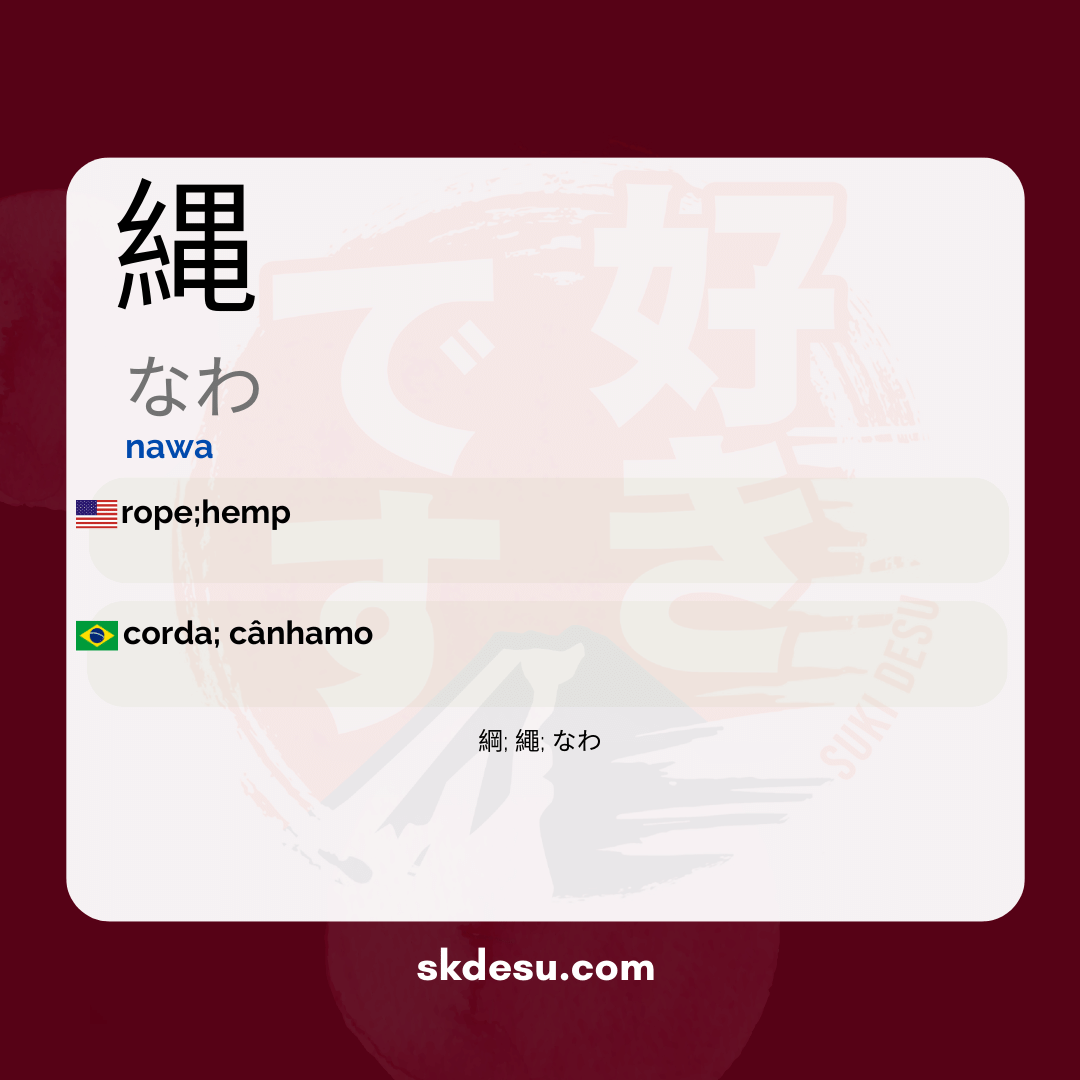Translation and Meaning of: 縄 - nawa
The Japanese word 縄 (なわ, nawa) may seem simple, but it carries deep meanings and varied uses in everyday life and culture in Japan. If you are learning Japanese or just curious about the language, understanding terms like this can enrich your linguistic and cultural knowledge. In this article, we will explore the meaning, origin, and contexts in which this word is used, as well as practical tips for memorizing it.
縄 is often associated with everyday objects, but it also appears in expressions and historical contexts. Whether for those studying Japanese or for those seeking to understand more about the language, knowing this word can be useful both in conversations and in understanding texts. Let's dive into the details of 縄 and discover how it is perceived by native speakers.
Meaning and usage of 縄 (なわ)
縄 means "rope" in Japanese, referring to an object made of twisted fibers used to tie, bind, or decorate. Unlike ロープ (rōpu, from English "rope"), which is more associated with thick or industrial ropes, 縄 has a more traditional tone and can be made from materials like straw, hemp, or even modern synthetic fibers.
In Japan, braided straw ropes, known as しめ縄 (shimenawa), are used in Shinto shrines to demarcate sacred spaces. This specific use shows how the word goes beyond its literal meaning, connecting to religious and cultural practices. In everyday contexts, 縄 may appear in phrases like "縄で縛る" (nawa de shibaru, "to tie with a rope"), demonstrating its practical function.
Origin and writing of the kanji 縄
The kanji 縄 is composed of the radical 糸 (ito, "thread") on the left, indicating its relation to woven objects, and the component 黽 (min, originally associated with creatures like frogs) on the right, which primarily serves as a phonetic indicator. Despite its complex appearance, this kanji is classified as of medium level in the JLPT (N2), being more common in texts than in informal conversations.
Interestingly, 縄 (with the radical 巾, "cloth") is an ancient variant of the same kanji, but nowadays the standard form is 縄. This evolution in writing reflects changes in the Japanese language over the centuries, solidifying in modern usage. For those studying kanji, noticing these details can aid in memorization and understanding the structure of words.
Tips to memorize and use 縄
An effective way to remember 縄 is to associate it with concrete objects, such as the ropes used in Japanese festivals or New Year's decorations. Visualizing the しめ縄 (shimenawa) hanging in shrines can create a strong mental connection, making memorization easier. Another tip is to practice with simple sentences, such as "その箱を縄で縛ってください" (Sono hako o nawa de shibatte kudasai, "Please tie that box with the rope").
Additionally, it is worth noting that 縄 is not an extremely common word in everyday life, but it appears in specific contexts, such as crafts, agriculture, or situations that involve tying. Knowing when to use it, in contrast with terms like ロープ or ひも (himo, "ribbon," "string"), can make a difference in language fluency. With practice and exposure to authentic materials, it becomes easier to incorporate 縄 into the active vocabulary.
Vocabulary
Expand your vocabulary with related words:
Synonyms and similar words
- 綱 (tsuna) - rope used in formal contexts, such as for boats or in ceremonies.
- 繩 (jō) - rope in a broader context, commonly used for tying or fastening.
- なわ (nawa) - string or line, the more colloquial term used in everyday life.
Romaji: nawa
Kana: なわ
Type: noun
L: jlpt-n3
Translation / Meaning: string; hemp
Meaning in English: rope;hemp
Definition: Twisted and curled fibers.
Quick Access
- Vocabulary
- Writing
- Sentences
How to Write in Japanese - (縄) nawa
See below a step-by-step guide on how to write the word by hand in Japanese. (縄) nawa:
Example Sentences - (縄) nawa
See below some example sentences:
Nawa o tsukatte asobu no wa tanoshii desu
Playing with rope is fun.
It's fun to play with a rope.
- 縄 (nawa) - rope
- を (wo) - object particle
- 使って (tsukatte) - using
- 遊ぶ (asobu) - play
- のは (no wa) - Topic particle
- 楽しい (tanoshii) - fun
- です (desu) - Ser/estar (polite form)
Okinawa wa utsukushii shima desu
Okinawa is a beautiful island.
- 沖縄 - Okinawa, name of the region the sentence refers to
- は - Topic marker, indicates that the subject of the sentence is Okinawa.
- 美しい - beautiful
- 島 - island
- です - verb to be in present, indicating that Okinawa is a beautiful island
Other Words of this Type: noun
See other words from our dictionary that are also: noun

